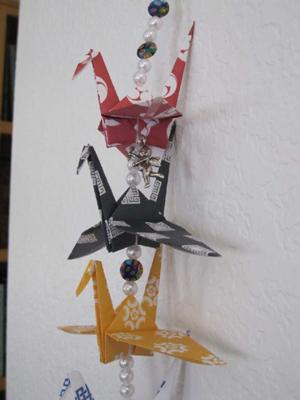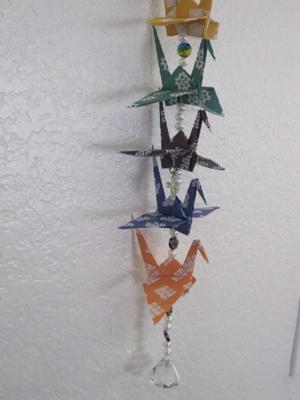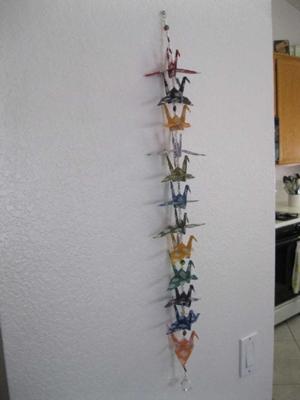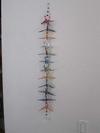Crane Chains
by PK2
(California)
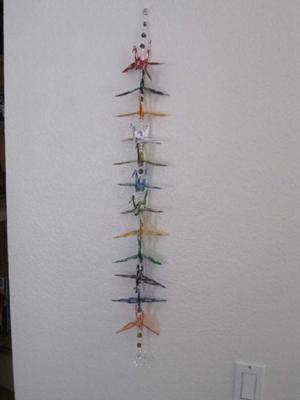
Crane Chain
These chains of twelve Cranes are created to bring hope, joy, inspiration and peace to others.
Background Information: Legend of the Crane
In many parts of the world cranes are revered as the messengers of the gods.
Cranes are symbols of happiness, justice, diligence, purity, loyalty, piety, filial gratitude, beauty, and love.
In China and Japan cranes are symbols of longevity and immortality. The crane in Japan is one of the mystical or holy creatures, and is said to live for a thousand years. In the empire of China, the crane was the symbol for a long life and wisdom.
In Greece, the crane is considered as symbol of watchfulness and intelligence.
In ancient Egyptian hieroglyphics, the figure of the crane represents the letter B.
The Aztecs of Mexico originally came from the region Aztlan, which meant "land of the crane" or "near the Crane" (azta = crane, tlan = near).
Representatives of the Crane family are found on all continents of the earth except in the Antarctic and South America. Once cranes have chosen a partner they will stay together for life.
About The Number 12
Religious beliefs were piled on top of respect for the number 12.
The ancient Zoroastrians had twelve commanders on the side of light (light being a symbol for the sun). The Greeks imagined 12 gods on Mount Olympus, and many of the gods had 12 sons.
Christians, believe that the Savior had 12 disciples, and Muslim Shi'as list 12 ruling Imams following Muhammad.
Buddhists hold that life is composed of 12 stages, which together keep the wheel of life turning, ensnaring all life in a cyclic form of existence from which it is hard to escape.
In Judaism, Jacob had 12 sons, who went on to procreate the twelve tribes of Israel, God's chosen people (God being the sun, with twelve divisions). So, as Christianity arose out of Judaism, it too inherited the reverence of the number 12. Jesus had 12 disciples.
There are 12 days of Christmas. The song Twelve Days of Christmas came from the traditional practice of extending Yuletide celebrations over the twelve days from Christmas day to the eve of Epiphany. Thus Twelfth Night is another name for the twelfth day of Christmas or January 5 (the eve of Epiphany). Similarly, Eastern Orthodoxy observes 12 Great Feasts.
There are twelve basic hues in the color wheel; 3 primary colors (red, yellow, blue), 3 secondary colors (orange, green & purple) and 6 tertiary colors (names for these vary, but are intermediates between the primaries and secondaries).
The calendar has twelve months in a year. There are twenty-four hours in a day in all, with twelve hours for a half a day. The hours are numbered from one to twelve for both a.m. and p.m. A new day is considered to start with the stroke of midnight (12). Furthermore, the basic units of time (60 seconds, 60 minutes, 24 hours) can all perfectly divide by twelve.
12 people make up a jury. No one is entirely sure why the number has been fixed at 12, but it is a precedent that dates back to the 12th century in the English Common Law. This number may come from religious history (12 apostles, 12 tribes of Israel).
Comments for Crane Chains
|
||
|
||
